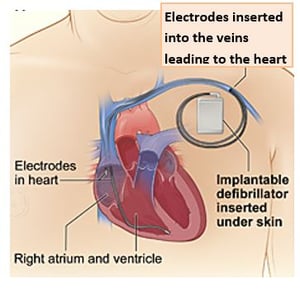Implantable Cardioverter Defibrillator
What is an implantable cardioverter defibrillator (ICD)?
An ICD is a small machine that listens to the heart’s electrical activity. If it finds a dangerously fast rhythm, it shocks the heart back to a normal rhythm. If needed, an ICD can also work as a pacemaker.
An ICD system has two parts:
1. The generator, which has a battery and a computer. The ICD generator is put under the skin or muscle in the upper chest.
2. The leads, which are wires that attach to the heart and connect to the ICD.
A doctor who specializes in heart rhythms will decide the best place to put the ICD. The placement is based on a person’s size and condition.
Why is it needed?
A dangerously fast heart rhythm can cause fainting or even death. An ICD is needed when medicine alone cannot control the rhythm.
How is it put in?
An ICD is put in by a doctor in the operating room. Medicine (anesthesia) is given so the patient is asleep during the surgery.
How should the incision be cared for?
Check the incision daily for signs of infection, such as fever, redness, swelling, or drainage. A shower may be taken after one week. Baths can be taken after two weeks. Pat the incision dry with a towel. Do not rub. If strips of tape were used, let them fall off on their own. If the strips of tape are still there after two weeks, they can be removed. Do not use lotions or ointments on the incision for at least six weeks after surgery.
What should I avoid after getting an ICD?
For the first month after surgery:
- Do not lift anything over 5 pounds with either arm.
- Do not lift anything over 10 pounds using both hands. A full gallon of milk weighs 8 pounds.
- Do not reach out with the arm closest to the ICD or lift it above the shoulder.
For six weeks after surgery:
Do not use a backpack. Ask the school counselor to help you get two sets of school books. One set can be used at home and one can be used at school. If there is only one set of books, use a rolling suitcase. Ask for help lifting the suitcase on or off the bus and up or down steps.
As long as an ICD is in place, avoid these things:
Anything that could interfere with the function of the ICD:
– Large magnets, including MRI procedures or toys with large magnets.
– Arc welders used in shops.
– Pottery kilns.
– Jumper cables attached to a car, large battery chargers, and power substations.
– Do not lean near running car engines.
Playing contact sports such as football, hockey, wrestling, and lacrosse. These sports can cause damage to the ICD. Please talk to your doctor about which sports are OK.
Leaning on or standing in security detection machines in stores. These may be tall and free-standing (see picture), or they may be part of the door. Walking through them normally is fine.
Security wands at security checks must not be placed directly over an ICD. When traveling, take your ICD identification card. Let security know about the ICD. They will do a pat-down security check.
Things that are safe
- Most dental procedures, including the drills, x-rays, and ultrasound. If you have a medical procedure, please let the doctor, dentist, surgeon, or nurse know about the ICD.
- Most household appliances and equipment that are grounded and in good working condition. This includes microwaves, video games, toasters, blenders, space heaters, lawnmowers, vacuum cleaners, drills, and small refrigerator magnets.
- Cell phones, MP3 players, wireless internet modems, large stereo speakers, hair dryers, electric toothbrushes, pagers, and sewing machines. Keep these items at least six inches from the ICD.




